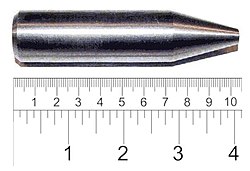
Stakalloy is a ternary alloy of uranium composed of vanadium, niobium, and depleted uranium. [1] The alloy was developed in 2002 by Michael R. Staker of Loyola University Maryland under grant from the United States Army. [2]

Stakalloy is a ternary alloy of uranium composed of vanadium, niobium, and depleted uranium. [1] The alloy was developed in 2002 by Michael R. Staker of Loyola University Maryland under grant from the United States Army. [2]
The niobium content of stakalloy is between 0.01 and 0.95 percent by weight and the balance being uranium. [1] The vanadium content of the alloy is between the gamma eutectoid and the eutectic compositions, 1.0 percent and 4.5 percent by weight respectively. [1]
Stakalloy has improved metallurgical properties over other depleted uranium alloys, such as staballoy, being more viable as a structural alloy where a combination between high strength and high density is required. [1] Changes include that of density, hardness, ballistic properties, and machinability. [1]

Staker's invention of stakalloy involved reducing excessive carbon levels while adding together uranium with trace amounts of niobium and vanadium. [1] The three constituent parts may be combined through melting, however, the niobium and vanadium must be charged into the melt or introduced to additional melt stock before heat-up. [1]
Arc melting is also a melting technique noted by Staker, in which niobium is added to an alloy of vanadium and uranium from a crucible. [1]
After casting an ingot of stakalloy, the ingot can be used in the as-cast condition or be worked—either hot or cold—to change both properties and shape. Stakalloy can also be heat-treated after manipulation of shape.

Stakalloy may be a viable replacement for the United States Army's Advanced Kinetic Energy round. [3] In 2007, Army Solicitation Notice W911QX-07-T-0053 entitled "Processing U-V-X Alloy Ingots" outlined work at Aerojet producing promising alloys with interesting material properties for future testing at the Army Research Laboratories. [3] [4]